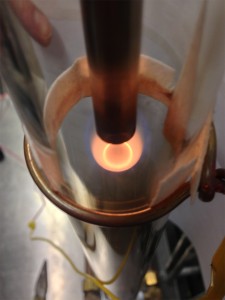Synthesis of Nanostructured Material in Flames for Biomedical and Energy applications
Synthesis Carbon Aerosol Gels in Inverted Flames
This approach for synthesis of structured nanomaterials (NM) is an alternative to the  current liquid-based aerogel synthesis. The approach replaces the complex liquid aerogel process with Inverted Flame Reactor (IFR) approach, with no need for extracting liquid component. The traditional combustion aerosol gel synthesis does not provide the ideal conditions for aerosol gelation; aerosol gels cannot be produced unless extremely sooting fuels are used and/or the gelation occurs as a results of explosion; neither approach is practical for the continuous production of NMs. The inverted flame has previously used for synthesis of amorphous carbon-based aerosol gels using highly sooting fuels. In the traditional (up-right) flame configuration the particle growth process ends shortly after the precursor particles exit the flame or their concentration becomes too dilute (few milliseconds). In the inverted flame, the recirculation zone traps the precursors, extending their residence time to several seconds, which allows gelation and leads to the formation of aerosol gels.
current liquid-based aerogel synthesis. The approach replaces the complex liquid aerogel process with Inverted Flame Reactor (IFR) approach, with no need for extracting liquid component. The traditional combustion aerosol gel synthesis does not provide the ideal conditions for aerosol gelation; aerosol gels cannot be produced unless extremely sooting fuels are used and/or the gelation occurs as a results of explosion; neither approach is practical for the continuous production of NMs. The inverted flame has previously used for synthesis of amorphous carbon-based aerosol gels using highly sooting fuels. In the traditional (up-right) flame configuration the particle growth process ends shortly after the precursor particles exit the flame or their concentration becomes too dilute (few milliseconds). In the inverted flame, the recirculation zone traps the precursors, extending their residence time to several seconds, which allows gelation and leads to the formation of aerosol gels.
TiO2 synthesis
The extended lifetime of precursor allows gelation to occur and leads to the formation of  high porosity aerosol gels and coatings. The inverted flame has been used for synthesis of amorphous carbon-based aerosol gels. Though these carbon gels may be of interest in some application they cannot be used in the grafts due to their cytotoxicity. TiO2 and other flame produced NPs (e.g. fumed silica, etc.) are used in the variety of applications. These particles do not have properties that are required for improving biocompatibility: the interface between the graft and tissue must stimulate bone regeneration and endothelial cells must form a network inside the scaffold to form blood vessels. Recently we have demonstrated synthesis of structured TiO2. The residence time in the IFR is 100-1000 times greater than in the typical flame synthesis allowing crystal growth from primary NPs.
high porosity aerosol gels and coatings. The inverted flame has been used for synthesis of amorphous carbon-based aerosol gels. Though these carbon gels may be of interest in some application they cannot be used in the grafts due to their cytotoxicity. TiO2 and other flame produced NPs (e.g. fumed silica, etc.) are used in the variety of applications. These particles do not have properties that are required for improving biocompatibility: the interface between the graft and tissue must stimulate bone regeneration and endothelial cells must form a network inside the scaffold to form blood vessels. Recently we have demonstrated synthesis of structured TiO2. The residence time in the IFR is 100-1000 times greater than in the typical flame synthesis allowing crystal growth from primary NPs.
References
- Rajan Chakrabarty, Igor Novosselov, Nicolas Beres, Hans Moosmuller, C M Sorenson, and Christopher Stipe. Gravity-induced Trapping and Aerogelation of Nanoparticles in Hydrocarbon Flames”, Appl. Phys. Lett. 104, 243103 (2014)
